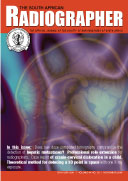Does low dose computed tomography compromise the detection of hepatic metastases?
Keywords:
Radiation dose, conspicuity, metastatic margins, noise levels.Abstract
The increase in the application of computed tomography (CT)as resulted in an increase in radiation dose to the population. Recent research studies have shown that lowering the radiation dose in CT examinations has resulted in images of similar quality compared to that of the standard dose. The aim of this study was to determine whether lowering the radiation dose during CT examination of the abdomen compromises the detection of hepatic metastases. Materials and methods: A sample of 16 patients was subjected to a CT examination of the abdomen during which a routine portal venous examination and an additional low dose sequence through the liver were performed. Two reviewers, who were blinded as to which images were acquired with low or standard dose, rated the quality of the images in terms of conspicuity, sharpness of the margins of the hepatic metastases, anatomical detail of the liver as well as image noise. Results: Conspicuity of the hepatic metastases was not compromised by the low dose sequence but margins of the hepatic metastases and anatomical detail were rated less favorable compared to the standard dose sequences. Noise levels on the low dose images were also rated higher than those obtained with standard dose. Conclusion: Lowering the radiation dose to patients does not compromise conspicuity of hepatic metastases. It is recommended that low dose CT should be used in especially patients being followed up with confirmed hepatic metastases in order to reduce the dose delivered to patients.Downloads
Published
2007-01-30
Issue
Section
Original Articles
License
Copyright on all published material belongs to the Society of Radiographers of South Africa (SORSA).I hereby understand and declare that:
- All proprietary rights other than copyright are reserved to the authors, as well as the right to reproduce original figures and tables from this item in their future works, provided full credit is given to the original publication The South African Radiographer ISSN 0258 0241.
- In consideration of the reviewing and editing done by the editors of The South African Radiographer of the above named manuscript, the author/s hereby transfer, assign, or otherwise convey all copyright ownership world-wide, in all languages, to the Society of Radiographers of South Africa in the event that this manuscript is accepted for publication.
- If the manuscript has been commissioned by another person or organisation, or if it has been written as part of the duties of an employee, that full authorization has been given by the representative of the commissioning organisation or employer to be published in the The South African Radiographer.


